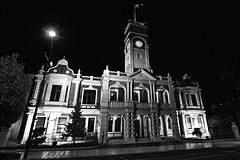Bear with me as I tell you the story of a place far away, but one whose story will sound familiar. Maybe all too familiar. It’s Toowoomba, a city of 120,000 in Australia’s interior. The funniest thing about Toowoomba is its name (it’s an Aboriginal word that means, more or less, swamp). Toowoomba isn’t actually in a swamp; it sits atop a range of low mountains and is known as a pretty place where people take pride in their gardens, their local university and their schools.
But as Charles Fishman describes in his new book, “The Big Thirst,” Toowoomba has a terrible problem, which it shares with the rest of Australia. It is running out of water. Australia is 10 years into a drought that has become such a part of Australian life that it is called simply “the Big Dry.” Toowoomba’s particular problem is that, because of its location, it suffers a little more than other places, as water runs quickly off its slopes.
By 2005, with the drought in its fifth year, Toowoomba had done the usual things, forbidding outdoor watering, hiring officers to look for scofflaws, and holding community religious services for residents to pray for rain. No luck. The city’s reservoirs were down to 34 percent of capacity, and political leaders were desperately looking for solutions, any solutions.
You can imagine, then, the excitement that Mayor Dianne Thorley felt when, in May 2005, she addressed a local women’s club with news of a breakthrough: For six months, she told the members, she and city water engineers had been studying water systems around the world and had a plan to recycle waste water as crystal-clear drinking water—extending the city reservoirs’ capacity and, possibly, saving the city.
The reaction? “Dumbfounded,” one who was at the meeting, Rosemary Morley, said. The city wanted to run water from the toilet to the tap? “I came home from that meeting,” she told Fishman, “and my reaction was, “˜How can you go forward with a project like that without running it by people?’ I thought, “˜This is such a sneaky thing. There must be something about it that’s funny.’ “
Even so, it took a while for opposition to build. In the meantime, the city council approved the plan unanimously. The governor of Queensland, where Toowoomba is located, endorsed it. So did the member of parliament from the city. And the national government offered to pay two-thirds of the cost of the advanced treatment facility needed for recycling water.
By then, though, a citizens’ rebellion had begun in earnest. A former mayor weighed in, calling it the work of “sewer sippers.” If it came to pass, he thundered, Toowoomba would be known as “Poowoomba.” A group called CADS, Citizens Against Drinking Sewage, organized. And the federal government, seeing the furor, changed its mind, saying it would participate only if the voters of Toowoomba agreed to it in a referendum.
You can imagine how this unfolded. On the one side, the mayor and water officials offered reason, science, detailed technical information and the experiences of far-off places (in the U.S., Fairfax County, Virginia, and Orange County, California recycle water) to assure voters that it was safe to drink thoroughly treated waste water. On the other side, opponents used slogans, scare tactics and pseudo-science. (Opponents brought in an out-of-town plumber who said he had been studying recycled water and learned it contained tiny amounts of hormones from drugs flushed down toilets. Drinking the water, he said, would cause men to grow breasts and lose their testicles. Keep in mind, this was scientific analysis . . . from a plumber.)
Proponents produced a 40-page book, Fishman writes, “with graphics of molecules and filter barriers, pages of text explaining the technology, photos of water in every possible mood, and many pictures of children.” Opponents issued an eight-page newspaper whose front page had a photo of brown sewage. Underneath, it asked, “Is this our city’s future?”
Well. You won’t be surprised that on July 29, 2006, the voters of Toowoomba said no to the water recycling idea by a thumping 62 percent majority. The only surprise is that it wasn’t unanimous.
As discouraging as Toowoomba’s experience was, it raises a good question: How can you deal with fear and demagoguery? This isn’t something that happens only in the Australian Outback or with proposals for recycling water. It happens every day in America, where complicated issues are put before voters promising an important benefit, but only if voters will pay a little more in taxes, change a familiar habit (such as commuting to work by train rather than car), or overcome their squeamishness. These ideas are sitting ducks for opponents whose only chore to come up with a slogan clever enough to play on citizens’ fears and doubts. When they do, the game is over.
What, then, can leaders do to lessen the inevitable resistance to new ideas and, maybe, win over skeptical citizens? The first thing is to do what Mayor Thorley (known in Toowoomba as Mayor Di) and her city hall allies never did: Recognize how much resistance there would be to such an unexpected and unconventional solution. Here’s how Fishman frames the mayor’s blindness:
What Mayor Di didn’t appreciate that day in May 2005 was that she was introducing a whole new way of thinking about water. She wasn’t being “sneaky”—to use Morley’s word—in the least. But Mayor Di didn’t seem to grasp that people might have different attitudes about water, and about what kind of water is wholesome.
What Mayor Thorley lacked was one of the essential ingredients of leadership: empathy, the ability to see the world from the others’ perspectives. She had been quickly converted to the idea of recycling water. She saw no reason others should take their time. When opposition mounted, she dug in her heels, insisting that the decision had been made, and critics should just get over it. “No consultation, no debate,” Rosemary Morley said. “That’s like waving a red flag in front of a bull.”
But realistically, had she been more empathetic, what could Mayor Thorley have done? She could have taken six months to let the public work through the conversion process that she had made in days. When she spoke to the women’s club, her announcement should have been that she was forming a large task force (made up of friends, critics and respected leaders) to look at solutions to the water crisis and involve the community in learning about the options. Recycling water could have been one of the options, but only one.
Knowing how squeamish this option would make people, she could have suggested video conferences between task force members and people in Orange County and Fairfax County. She could have suggested a partial solution: Build an advanced treatment facility but use the water only for non-drinking uses, such as for industrial processes or in city fountains. Then she could have put goldfish in the fountains and invited everyone to watch the fish. (One resident of Toowoomba actually suggested this idea. It would have been persuasive.) After people saw the fish thrive (with no harm to the males), she could have suggested finishing the project.
The secret to defeating fear is a lengthy, open but certain decision-making process, one that allows not just those involved in the decision but everyone an opportunity to learn about controversial ideas without being hurried, to explore alternatives, and discuss and reconcile their feelings. In the end, of course, you have to make a decision. But in most cases, you don’t have to do it at the snap of your fingers. And you don’t persuade others by telling them just to get over it.
So what happened to Toowoomba after the referendum? An advanced treatment plant was built in Toowoomba but only to supply water to a coal mine operator. (The facility doesn’t bring the water up to drinking standards.) Eventually, Toowoomba signed an agreement with another water system to pump drinking water up the mountain. The pipeline and pumping stations will cost about twice what the recycled water system would have and have much higher operating costs that will grow as the price of energy increases. Fear, it turns out, has a price. Toowoomba’s water users will be paying for their fears for many years to come.
And now, the final irony: The water system that’s supplying the water to Toowoomba is building . . . you guessed it, recycled water facilities. So while the citizens of Toowoomba won’t be drinking water that has passed through their own toilets, they’ll be drinking the water from others’.
Photo of Toowoomba City Hall by Tim Swinson licensed under Creative Commons.


